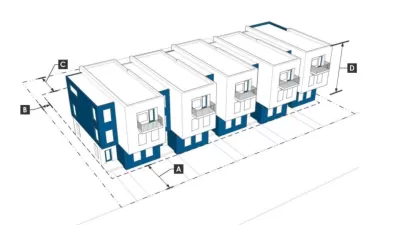New research shows that affordable housing mandates usually don't raise housing costs, but often fail to benefit benefit the lowest-income families.

Research from the National Housing Conference's Center for Housing Policy clarifies the impacts of inclusionary zoning policies, which require developers to include some affordable units in their buildings. Brentin Mock from CityLab summarizes the major findings.
The good: In most cases, inclusionary zoning requirements haven't driven housing costs up. Nor have they slowed housing production. Those findings challenge the argument of some developers who oppose affordable-housing mandates, especially in California.
The bad: Inclusionary zoning policies have largely failed to create affordable housing for the lowest-income households—and most policies aren't designed to target them. That can lead to a lack of support for programs:
After all, if it’s going to be called “inclusionary zoning,” it should include those who are most in need of housing. People actually need to be able to buy into the properties in order to buy in to the policy.
Pittsburgh is considering ways to address this problem, which Washington, D.C. also dealt with recently. San Francisco, New York, Seattle, and more cities throughout the United States have also recently taken up questions around inclusionary zoning.
The research also notes that the success of these policies is influenced by factors that can vary by city and over time, like the strength of an area’s housing market or a policy's compatibility with state law.
FULL STORY: Inclusionary Zoning Does Not Drive Up Housing Costs

Pennsylvania Mall Conversion Bill Passes House
If passed, the bill would promote the adaptive reuse of defunct commercial buildings.

Planning for Accessibility: Proximity is More Important than Mobility
Accessibility-based planning minimizes the distance that people must travel to reach desired services and activities. Measured this way, increased density can provide more total benefits than increased speeds.

World's Largest Wildlife Overpass In the Works in Los Angeles County
Caltrans will soon close half of the 101 Freeway in order to continue construction of the Wallis Annenberg Wildlife Crossing near Agoura Hills in Los Angeles County.

Eviction Looms for Low-Income Tenants as Rent Debt Rises
Nonprofit housing operators across the country face almost $10 billion in rent debt.

Brightline West Breaks Ground
The high-speed rail line will link Las Vegas and the Los Angeles area.

Colorado Bans No-Fault Evictions
In most cases, landlords must provide a just cause for evicting tenants.
City of Costa Mesa
Licking County
Barrett Planning Group LLC
HUD's Office of Policy Development and Research
Mpact Transit + Community
HUD's Office of Policy Development and Research
Tufts University, Department of Urban and Environmental Policy & Planning
City of Universal City TX
ULI Northwest Arkansas
Urban Design for Planners 1: Software Tools
This six-course series explores essential urban design concepts using open source software and equips planners with the tools they need to participate fully in the urban design process.
Planning for Universal Design
Learn the tools for implementing Universal Design in planning regulations.


























